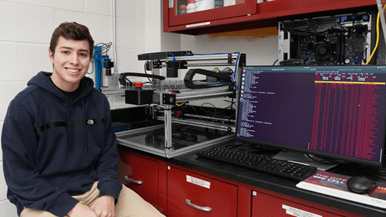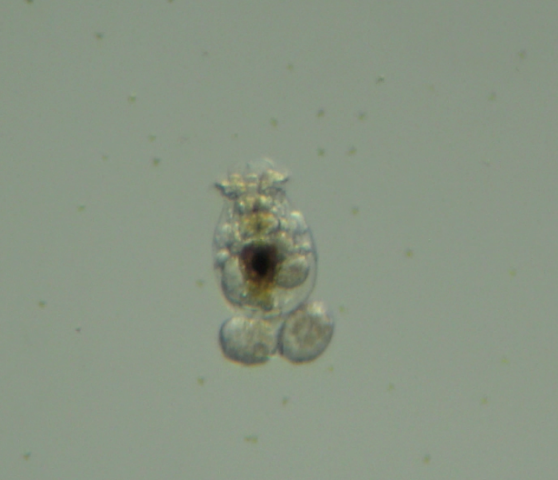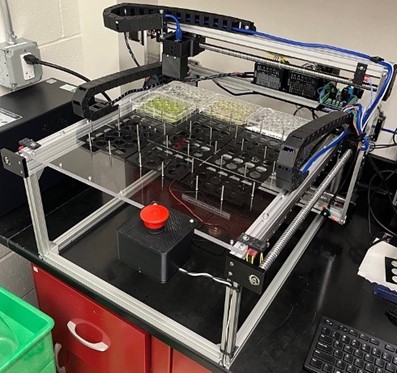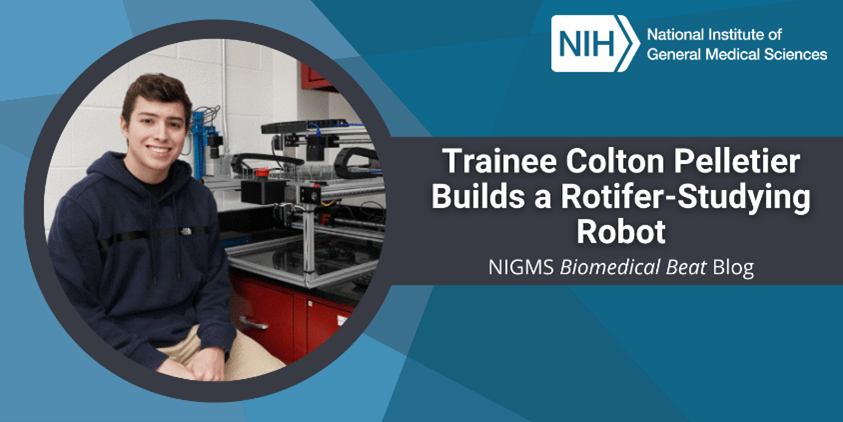
During his time at Roger Williams University (RWU) in Bristol, Rhode Island, Colton Pelletier built a robot that will help simplify data collection for research projects in the lab he worked in—and others—for years to come. Aiding in Colton’s success in the lab was NIGMS funding through the Institutional Development Award (IDeA) Networks of Biomedical Research Excellence (INBRE) program. INBRE funds statewide networks of higher education in IDeA states such as Rhode Island, which have historically received low levels of NIH funding. The program supports faculty research, mentoring, student participation in research, and research infrastructure by connecting primarily undergraduate institutions with research-intensive universities in the state.
Building Roti-Bot
During his sophomore year, Colton joined the Molecular Longevity Laboratory of Christopher Burtner, Ph.D. Researchers in the lab work to understand the genetic and biochemical components of aging and longevity—how long cells and organisms live—using research organisms like Caenorhabditis elegans (a roundworm) and Brachionus plicatilis (a microscopic aquatic animal, also known as a rotifer).

Colton started working on a project testing the ability of various medicines to lengthen the lifespan of rotifers, which is normally about 21 days. This work could help researchers understand the molecular changes that happen in advanced age in humans. But the project required Colton and his fellow researchers to check on the rotifers multiple times per day for the entire 3 weeks, so they decided to build a robot that would help automate the process.
They started with a preexisting robotic system called Worm-Bot that was developed by researchers at the University of Washington Healthy Aging and Longevity Research Institute in Seattle to answer similar questions in roundworms. Worm-Bot takes pictures of worms around the clock so researchers don’t have to check on them. Roundworms live in a semisolid media, but rotifers live in liquid media, which made the light from the robot’s camera too bright.
“Adapting Worm-Bot into Roti-Bot was the focus of my entire first summer in the lab. It took a lot of trial and error trying to find the conditions that allowed for the best images,” Colton says. With the help of 3D-printing experts at RWU, Colton designed and printed three different attachments to change how much light reached the dishes that the rotifers lived in.

With these adjustments, Roti-Bot was born. Every 30 minutes, it takes two images of each dish 5 seconds apart. If a rotifer is alive, it will move during the 5 seconds between images, allowing a researcher to compare the images to determine how many rotifers are still alive. However, Roti-Bot created too many pictures for Colton and his lab mates to look at manually. With the help of Hum Nath Bhandari, Ph.D., an assistant professor in mathematics at RWU, they wrote a computer program that overlays the image pairs and performs image subtraction to highlight where the images differ.
But the optimization didn’t stop there. To avoid needing to manually review thousands of image-subtraction photos, Colton and Dr. Bhandari used a machine learning algorithm. The algorithm produces a count of living rotifers from the output of the image subtraction step and exports the data into a spreadsheet—all without human intervention. “We’re able to run experiments comparing the lifespans of rotifers growing in the presence of various medicines, and in the end, we get great graphs of lifespans essentially without looking under the microscope,” Colton says.
He has seen some promising early results—one medicine extended rotifer lifespan past 21 days, which opens the door for researchers to further investigate the medicine, including how it may be altering longevity at the molecular level. Naturally, Colton is excited about his results. “Part of verifying that rotifers are good models for aging studies is showing that medicines that extend lifespans in other models, like roundworms, also extend lifespan in rotifers, and we accomplished that. We’ve shown that Roti-Bot is an effective system for these research questions.”
Colton graduated from RWU in the spring of 2024 with majors in biology and applied mathematics, but the other members of his lab have continued to work on his project. In the fall, he’ll start graduate school to pursue a Ph.D. in molecular cell biology and neuroscience at Rowan University in Glassboro, New Jersey. He hopes one day to have his own lab and the opportunity to teach.
Colton was supported by the NIGMS-funded Rhode Island INBRE through grant P20GM103430.







